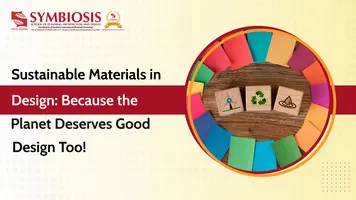
Sustainable Materials in Design: Because the Planet Deserves Good Design Too!
As designers, we have a superpower—shaping the world around us. Whether it’s the poster on a wall, the website on your screen, the chair you’re sitting on, or the entire space you’re in, design influences everything. But here’s the catch: every design decision also impacts the environment.
Sustainability isn’t just a buzzword—it’s a responsibility. And at SSPAD, we believe good design isn’t just about looking pretty or functioning well; it should also be kind to the planet. So, how do you make your student projects more eco-friendly? Let’s break it down, discipline by discipline.
Yes, digital is king, but print isn’t going anywhere. So, when you do print, make it count.
- Recycled & FSC-Certified Paper – Your posters and packaging don’t have to cost trees their lives.
- Soy-Based Inks – Traditional inks - bad for the planet. Soy-based inks = vibrant, eco-friendly, and smell like victory.
- Minimalist Packaging - Less is more. Can your box fold smarter? Can it be reused? Make your packaging work harder with less.
“But UX is digital, so it’s already sustainable, right?” Nope. The internet has a huge carbon footprint. Be a responsible UX designer:
- Lightweight Websites – Optimize images, ditch unnecessary plug-ins, and speed up load times. Faster = less energy used.
- Fewer Clicks, More Impact – Every extra step burns data and power. Simplify user journeys and make interactions efficient.
Your materials matter more than you think. The future of product design is all about sustainability:
- Bamboo & Cork – Grow fast, last long. Unlike plastic, they don’t take 500 years to break down.
- Recycled Plastics – If plastic must be used, make it recycled. Or better yet, make it recyclable.
- Modular & Repairable – Design things that don’t end up in landfills after one broken part. Think LEGO, but for everything.
Sustainable interiors aren’t just for eco-resorts; they’re the future of all design:
- Reclaimed Wood & Upcycled Furniture – Old materials, fresh new vibes.
- Non-Toxic Paints – Because breathing in chemicals every day isn’t cute.
- Sustainable Fabrics – Organic cotton, hemp, and linen make spaces look and feel amazing (minus the environmental guilt).
- Question Everything. Before choosing a material, ask: “Is there a greener alternative?”
- Reuse & Reduce. Use scraps for mock-ups, go digital whenever possible, and get creative with leftovers.
- Think Circular. Can your design be repaired, repurposed, or recycled? If not, rethink it.
Sustainability in design isn’t about perfection; it’s about progress. Every tiny, conscious decision adds up. So, whether you’re designing a poster, a product, a website, or a full-blown interior, remember: great design should be beautiful, functional, and responsible.
Because a well-designed future is one where the planet is still around to appreciate it.



